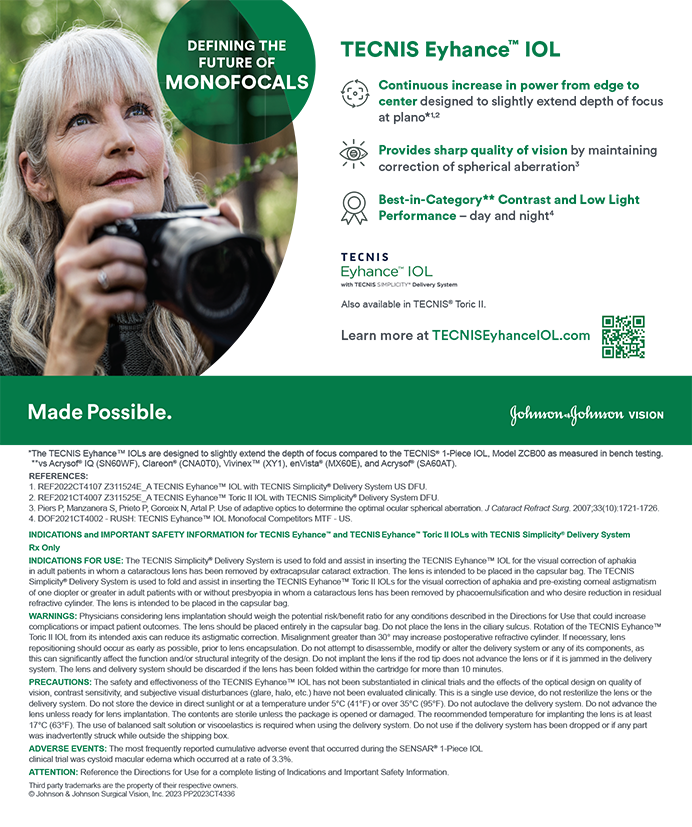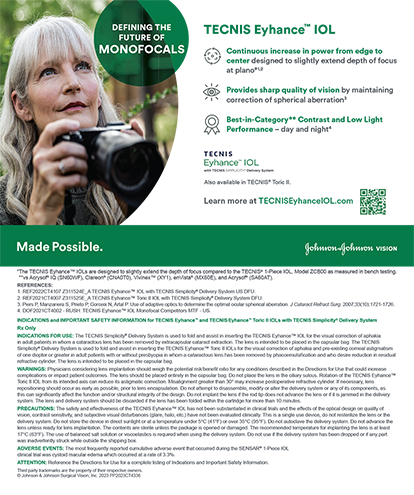Factors to Consider Before Making the Investment
By Farrell C. “Toby” Tyson, MD, FACS

Adopting new technology can transform and invigorate your practice by enhancing surgical efficiency, improving patient experiences and outcomes, and even driving referrals. The decision can also be daunting, raising concerns about usability, reliability, maintenance, staff training, and return on investment.
Laser technologies are relatively expensive, making careful evaluation essential. Several key factors contribute to a sound decision and smooth integration. This article provides advice based on my practice’s recent purchase and integration of the Teneo excimer laser platform (Bausch + Lomb).
THE NATURE OF THE PRACTICE
Consider the size, nature, and needs of your practice.
Having used excimer laser technology since before LASIK, I was excited about the US FDA approval of the Teneo—the first excimer laser to enter the US market in 17 years. Because I am a refractive cataract surgeon, however, my patient demographics skew older, meaning LASIK and PRK are not the focus of my practice. We therefore recognized that any excimer laser we purchased would not be in constant use. The Teneo’s small footprint compared to previous-generation excimer lasers is therefore an advantage because the space saved can be used for other revenue-generating purposes. Additionally, the technology is compatible with different manufacturers’ laser flap cutters, providing flexibility in the configuration of our laser suite.
USABILITY
How quickly and easily can your staff train on new technology?
We cross-train our staff. They may work in the OR one day and the clinic the next. This transition must be seamless. A complex piece of equipment that requires multiple steps to start up and maintain can cause challenges and frustration. Moreover, the more complex the system is, the fewer staff members can operate and maintain it, resulting in staffing inflexibility.
We evaluated the user-friendliness of various platforms and noted features that might offer advantages. For example, the Teneo’s customizable touchscreen simplifies setup for technicians. The integration of the computer into the system, instead of requiring a separate laptop, kept us from having one more device to manage. Additionally, the absence of nomograms was a significant time-saver.
SPEED AND EFFICIENCY
Every second counts when you are trying to keep a busy clinic flowing smoothly and efficiently. The speed at which any device operates is important to understand. How long does it take to set up for treatment? How much will it add to your procedural time?
During my evaluation of the Teneo, a feature that stood out to me was its fast eye-tracker (1,740 Hz). This speed ensures no wasted steps, minimizes tissue desiccation, and allows the planned treatment to be applied accurately to the cornea without changes due to eye movement.
PATIENT EXPERIENCE
The design of a surgical platform affects the patient experience. Key considerations include whether the environment feels intimidating or uncomfortable and if the bed can be adjusted for patients of various shapes and sizes. The Teneo treatment bed addresses these concerns by swinging out for easy access and offering customization for optimal head positioning.
SURGEON COMFORT AND POSITIONING
When I was a young surgeon in training, professors and experienced surgeons often offered the following advice: “Take the time to get yourself comfortable before you start the case.” It was difficult for me to appreciate the value of this step back then. Twenty years later, I understand its importance, especially at the start of a long surgical day. Ensuring comfort and proper positioning is crucial.
The Teneo platform has a joystick on an articulating arm that can be adjusted according to the surgeon’s preference. Controls are positioned in front, within easy view, and the main power screen is large and conveniently located.
PERFORMANCE AND OUTCOMES
Ultimately, the quality of the outcomes that a technology delivers is what matters most. Many impressive innovations—from new laser platforms to advanced-technology IOLs—are available that address and eliminate compromises faced with older technologies.
MAKING THE RIGHT CHOICE
I recommend reviewing clinical trial data to evaluate the efficacy and safety of any technology you are considering. Consult colleagues who have used the device and discuss their experiences. This approach should help you select a technology that delivers exceptional outcomes for both you and your patients.
Key Innovations and Practical Insights
By George O. Waring IV, MD, FACS

Significant advances in refractive surgery over the years have led to the development of a subspecialty that encompasses both corneal and lens-based procedures. The advent of laser technology has made the corneal journey particularly exciting. Historically, excimer lasers were the mainstay, but femtosecond lasers recently expanded our capabilities by enabling lamellar flap creation and lenticule extraction for the treatment of myopia and myopic astigmatism.
THE EVOLUTION OF EXCIMER LASER TECHNOLOGY
The use of excimer laser technology in refractive surgery was initially focused on the treatment of lower-order aberrations. Early excimer lasers were crucial to the development of wavefront-guided treatments, which are designed to correct the unique imperfections in each eye by mapping and addressing whole eye aberrations guided by a wavefront diagnostic device.
Wavefront-optimized lasers were subsequently developed to optimize the ablation profile by utilizing radial ablation efficiencies to minimize spherical aberration induction. Efficiencies continue to evolve with the advent of excimer lasers with high repetition rates. The Waring Vision Institute adopted the first high-speed 500-Hz excimer laser available in the United States, and we performed the first LASIK and PRK procedures with it in the country over a decade ago. More recently, topography-guided LASIK was introduced to the US market, adding potentially another layer of precision for treatment planning and the possibility for therapeutic use.
In February, a new entry into the excimer laser market was approved by the US FDA, the Teneo excimer laser. As part of the team of principal investigators for the US FDA clinical trial, we gained valuable insights into the platform’s safety, efficacy, and efficiency. Soon after its US FDA approval, we performed the first commercial LASIK and PRK treatments with the Teneo in the United States (Figure).

Figure. Dr. Waring performs the first LASIK surgery using the Teneo laser in the United States.
INTEGRATION PROCESS
Cost-Benefit Analysis
Adopting new technology involves a careful cost-benefit analysis. Each practice should conduct its own assessment of the financial implications. We consider not only the direct costs but also the efficiencies gained in surgical time, staff time, and space utilization. With the Teneo, the reduction in surgical and perioperative time achieved through features such as the laser not requiring a nomogram or manual adjustments by the physician have contributed to a favorable cost-benefit ratio.
Training and Certification
Integrating new technology involves thorough training and certification. Our team, accustomed to being early adopters, prepares extensively before the first cases. This includes training sessions and preprocedure meetings to ensure everyone is confident and ready.
Patient Education and Communication
Educating patients about new technologies is important. We emphasize that the cutting-edge technologies we use are not experimental but thoroughly tested innovations. This reassures patients and fosters trust.
SHARING INSIGHTS
We often receive inquiries from other surgeons about integrating new technologies. We strive to provide objective, balanced information when sharing our experiences with various platforms. As early adopters, we may face delays in the approval of additional indications, necessitating the temporary use of multiple platforms. The overall benefits of using the latest refractive technology, however, are significant.
STAYING AT THE FOREFRONT
The field of refractive surgery has a rich pipeline of new technologies. These include the next generation of truly accommodative, bag-filling IOLs and refractive index shape–changing IOLs. Engaging with these developments helps us to remain at the forefront of innovation.
Our commitment to integrating new laser technologies is driven by our goal to provide the best possible outcomes for our patients. Focusing on safety, efficacy, and efficiency and leveraging our role as US FDA investigators allows our practice to adopt new technologies smoothly and effectively. This approach not only enhances patient outcomes but also optimizes practice efficiency and workflow.




